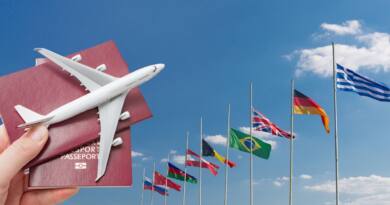The New American Ban Of The Countries: Know It All
The New American Gatekeeping: What Trump’s 2025 Travel Ban Means for the World – And for Indians Abroad. From border crackdowns to sweeping visa restrictions, the second Trump administration is redrawing the global map of mobility and triggering unease across communities, including the Indian diaspora.
World Politics | The WFY Magazine | June 2025 Edition
In a world still recovering from the aftershocks of a global pandemic, political volatility, and conflicts in multiple theatres, the resurgence of Donald Trump to the White House in 2025 has brought with it a reinvigorated focus on immigration control and national security. The latest demonstration of this agenda came on 5 June 2025, when President Trump signed a new executive proclamation that enforces a total travel ban on citizens from 12 countries and partial restrictions on seven others — a move that has stunned many and drawn sharp responses from across the globe.
Branded as a measure to protect the United States from foreign terrorists and “unverifiable nationals,” the proclamation has implications not just for the blacklisted countries, but for the wider international community — particularly students, business travellers, refugees, and diaspora populations.
At its core, the policy underscores Trump’s overarching theme: America’s borders must be tightly guarded, and anyone not verifiably safe is no longer welcome — even temporarily. While India is not on the list, the cascading effects of such policy shifts are already being felt among Indian nationals abroad and members of the broader Indian diaspora in the U.S., raising fears of future inclusion, heightened scrutiny, or collateral damage in a sweeping policy net.
The New Travel Ban: Who’s Affected?
The proclamation, which takes effect at 12:01 am EDT on 9 June 2025, imposes:
Total travel bans on citizens from the following 12 countries:
- Afghanistan
- Myanmar
- Chad
- Democratic Republic of Congo
- Equatorial Guinea
- Eritrea
- Haiti
- Iran
- Libya
- Somalia
- Sudan
- Yemen
Partial entry restrictions on travellers from:
- Burundi
- Cuba
- Laos
- Sierra Leone
- Togo
- Turkmenistan
- Venezuela
The restrictions range from complete visa ineligibility to tighter scrutiny, suspension of specific visa categories (like student or work permits), and additional biometric screening. Notably, visas issued before 9 June remain valid, although entry may still be delayed or blocked based on new screening criteria.
What Prompted the Ban?
The Trump administration has justified the ban based on several factors:
- High terrorist presence or activity in origin countries
- Failure to cooperate with U.S. visa security standards
- Lack of adequate traveller identification systems
- High rates of visa overstays and undocumented presence
- Unreliable criminal history records and background checks
In a video posted on X (formerly Twitter), President Trump declared:
“We will not allow people to enter our country who wish to do us harm. We cannot have open migration from countries that do not cooperate or where we cannot reliably vet people.”
He cited recent events, including a gasoline bomb attack at a pro-Israel rally in Colorado, allegedly perpetrated by an Egyptian national overstaying his tourist visa, as justification for the tighter policies — even though Egypt was not included on the list.
A Recurring Playbook: Echoes from the Past
This is not the first time such sweeping measures have been employed. In 2017, during his first term, Trump issued a controversial “Muslim Ban” that initially blocked travellers from seven Muslim-majority countries. That order was legally challenged but eventually upheld by the U.S. Supreme Court in 2018.
When President Joe Biden assumed office in 2021, he swiftly rescinded the ban, calling it “a stain on the nation’s conscience” and signalling a more inclusive approach to immigration. That policy reversal now lies in tatters.
The current list reintroduces most of the previously banned countries — with additional nations from Africa, Southeast Asia, and Latin America — expanding both the scope and ideological ambition behind the act. Critics say this is less about national security and more about a political message of exclusion, targeting vulnerable nations unlikely to retaliate diplomatically.
The Global Fallout: Protests, Uncertainty, and Diplomatic Firestorms
Somalia was one of the first nations to respond diplomatically. Its ambassador in Washington, Dahir Hassan Abdi, issued a statement saying:
“Somalia values its longstanding relationship with the United States and stands ready to engage in dialogue to address the concerns raised.”
Meanwhile, Venezuelan Interior Minister Diosdado Cabello condemned the policy outright, labelling the U.S. as “fascist” and warning Venezuelans of the risks of living in the United States, citing persecution and arbitrary deportation.
In Myanmar, the ban has already upended professional and academic opportunities. One teacher selected for a prestigious U.S. State Department exchange programme now faces the cancellation of her visa application, despite months of preparation. “We worked hard to get accepted,” she said, speaking from Thailand. “Now everything is uncertain.”
Anxieties Among the Indian Diaspora
While India is not directly affected, concerns are rising among Indians living in the U.S. and those seeking admission for education, work, or resettlement.
The policy’s broad framing of national security, increased scrutiny of visa applications, and precedents of sudden inclusion have created an atmosphere of anxiety. Indian nationals represent the second-largest group of international students in the U.S., with over 268,000 students enrolled in 2024 according to the U.S. Department of Homeland Security.
Increased vetting, delays in visa processing, and reduced tolerance for administrative errors have already been reported at consulates in New Delhi, Mumbai, and Hyderabad.
There is also growing concern that future extensions of the ban could target other countries with high student migration, temporary workers, or communities under suspicion — India being a prime candidate, especially amid increasing tensions over visa overstays, H-1B programme abuses, and geopolitical friction with China and Russia.
Academic and Business Implications
The academic community in the U.S. is reacting with frustration and alarm. Universities, particularly those with strong foreign exchange and research collaborations, have warned of the policy’s chilling effect.
“Such sweeping travel bans damage the credibility of American higher education,” said Dr. Angela Rodriguez, Dean of Global Affairs at the University of California. “They undermine academic freedom, diversity, and U.S. soft power.”
For Indian tech professionals and business travellers, the risks are more subtle but no less serious. Companies are re-evaluating their visa strategies, and legal advisors are urging caution with documentation, especially in H-1B and L-1 categories, which are already under enhanced scrutiny due to past fraud allegations.
A Broader Vision: Trump’s Immigration Doctrine 2.0
The travel ban is just one element in a broader immigration strategy set forth by the Trump administration in 2025:
- Mass deportations of suspected gang members, particularly targeting Venezuelans and Central Americans, with reports of aggressive detentions in cities like Miami, Los Angeles, and Houston.
- Tightening of student visa eligibility, with a proposed cap on certain nationalities.
- New executive orders requiring extended vetting of any foreign nationals from “high-risk” regions, including digital surveillance, social media tracking, and third-party background checks.
- A proposed bill in Congress that would deny citizenship to children born in the U.S. to undocumented immigrants — a direct challenge to the 14th Amendment.
Together, these actions suggest a complete ideological shift from immigration as enrichment to immigration as risk.
Is There Legal Recourse?
Civil liberties groups like the ACLU, National Immigration Law Center, and American-Arab Anti-Discrimination Committee have signalled they will challenge the proclamation in court, much like they did in 2017.
But given the current conservative majority on the Supreme Court, chances of a successful overturn remain uncertain. The Court’s 2018 decision upholding Trump’s original travel ban still sets a legal precedent — one that the administration may again rely on.
Indian Government Response: Watchful but Muted
India’s Ministry of External Affairs (MEA) has so far avoided any official comment, perhaps reflecting a careful balancing act. With over 4.8 million Indian-origin individuals in the U.S., and a growing Indo-Pacific strategic alignment, New Delhi is wary of escalating tensions.
Privately, however, diplomatic sources indicate concern over potential spill-over, particularly if visa denials or racial profiling incidents begin to affect Indian students and professionals disproportionately.
What Can Indian Nationals Do?
Legal experts and immigration consultants in both India and the U.S. advise all Indian applicants and residents to:
- Double-check all visa documents, especially expiration dates and travel histories.
- Avoid unnecessary travel if you are already in the U.S. on temporary status.
- Stay informed through official channels, not just social media or hearsay.
- Consult a qualified immigration attorney before making any changes to status, employment, or residency.
The Road Ahead
The Trump administration’s renewed travel ban is more than a bureaucratic update — it is a clear political statement. It reflects a worldview where migration is no longer seen as an asset but as a security threat, and where multilateral engagement is overshadowed by domestic assertion.
For the Indian diaspora — especially young students, aspiring professionals, and families seeking to build a future in the U.S. — this development is a call to vigilance and preparation. While India is not yet on the list, the global message is unmistakable: the gate is open only to those who pass the new ideological test.
Whether this marks the beginning of a larger decoupling or simply another phase in the long story of American migration politics will depend on legal pushback, diplomatic pressure, and — crucially — the 2026 midterm elections.
By Selvan Durairaj
© The WFY Magazine – June 2025 | World Politics
Email: wfymagazine@gmail.com
Website: www.thewfy.com




